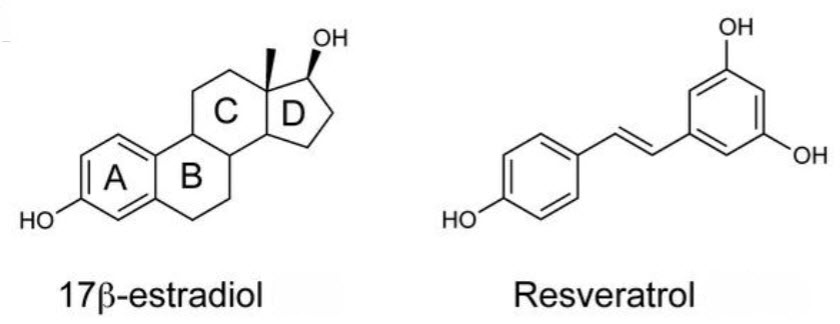The molecular secrets behind resveratrol’s health benefits
May 1, 2014

Resveratrol achieves estrogen benefits without the cancer risk (credit: The Scripps Research Institute)
Resveratrol has been much in the news as the component of grapes and red wine associated with reducing “bad cholesterol,” heart disease and some types of cancer. Also found in blueberries, cranberries, mulberries, peanuts and pistachios, resveratrol is associated with beneficial health effects in aging, inflammation and metabolism.
Scientists from the Florida campus of The Scripps Research Institute (TSRI) have identified one of the molecular pathways that resveratrol uses to achieve its beneficial action: it controls the body’s inflammatory response as a binding partner with the estrogen receptor.
It does this without stimulating estrogenic cell proliferation, which is good news for resveratrol’s possible use as a model for drug design. “Estrogen has beneficial effects on conditions like diabetes and obesity but may increase cancer risk,” said Kendall Nettles, a TSRI associate professor who led the study. “What hasn’t been well understood until now is that you can achieve those same beneficial effects with something like resveratrol.”
Compounds better than resveratrol
The problem with resveratrol, Nettles said, is that it really doesn’t work very efficiently in the body. “Now that we understand that we can do this through the estrogen receptor, there might compounds other than resveratrol out there that can do the same thing — only better,” he said.
In the new study, Nettles, Nwachukwu and their colleagues found that resveratrol is an effective inhibitor of interleukin 6 (IL-6), a pro-inflammatory protein that is part of the immune system (although IL-6 can be anti-inflammatory during exercise). High levels of IL-6 are also associated with poor breast cancer patient survival. According to the study, resveratrol regulates IL-6 without stimulating cell proliferation by altering a number of co-regulators of the estrogen receptor.
Researchers at the University of Illinois and PamGene International (The Netherlands) were also involved in the study. The study was published in the online journal eLife (open access) and supported by the National Institutes of Health, the Ballen Isles Men’s Golf Association, the Frenchman’s Creek Women for Cancer Research, the State of Florida and the James and Esther King Biomedical Research Program, Florida Department of Health.
Abstract of eLife paper
Resveratrol has beneficial effects on aging, inflammation and metabolism, which are thought to result from activation of the lysine deacetylase, sirtuin 1 (SIRT1), the cAMP pathway, or AMP-activated protein kinase. Here we report that resveratrol acts as a pathway-selective estrogen receptor-α (ERα) ligand to modulate the inflammatory response but not cell proliferation. A crystal structure of the ERα ligand-binding domain (LBD) as a complex with resveratrol revealed a unique perturbation of the coactivator-binding surface, consistent with an altered coregulator recruitment profile. Gene expression analyses revealed significant overlap of TNFα genes modulated by resveratrol and estradiol. Furthermore, the ability of resveratrol to suppress interleukin-6 transcription was shown to require ERα and several ERα coregulators, suggesting that ERα functions as a primary conduit for resveratrol activity.